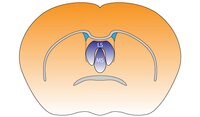
Photo from wikipedia
Fear is an extreme form of aversion that underlies pathological conditions such as panic or phobias. Fear conditioning (FC) is the best-understood model of fear learning. In FC the context… Click to show full abstract
Fear is an extreme form of aversion that underlies pathological conditions such as panic or phobias. Fear conditioning (FC) is the best-understood model of fear learning. In FC the context and a cue are independently associated with a threatening unconditioned stimulus (US). The lateral habenula (LHb) is a general encoder of aversion. However, its role in fear learning remains poorly understood. Here we studied in rats the role of the LHb in FC using optogenetics and pharmacological tools. We found that inhibition or activation of the LHb during entire FC training impaired both cued and contextual FC. In contrast, optogenetic inhibition of the LHb restricted to cue and US presentation impaired cued but not contextual FC. In either case, simultaneous activation of contextual and cued components of FC, by the presentation of the cue in the training context, recovered the conditioned fear response. Our results support the notion that the LHb is required for the formation of independent contextual and cued fear memories, a previously uncharacterized function for this structure, that could be critical in fear generalization.
Journal Title: Neuropsychopharmacology
Year Published: 2022
Link to full text (if available)
Share on Social Media: Sign Up to like & get
recommendations!